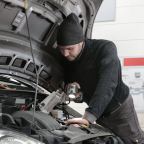
Tyre Care Tips to Ensure Your Car’s Safety
It can be argued that, as the only part of your car to touch the ground, your tyres are the most important part of your vehicle. While others may prefer to discuss engine performance, sharp and responsive brakes, or even techy details which help to keep you alerted to potential hazards, your tyres are the one point on which all these features rely. As such, it is essential to keep your tyres in great working order all the time.
You can stay on top of your tyre's performance by undertaking a little checklist every week if you drive a lot, or every month if you are a more casual commuter, especially in major UK cities like London . When driving, pay attention to how they feel when you brake or accelerate. Once parked, walk around your car, looking at your tyres closely, and use a torch to see them in as much detail as possible. You should look at:
Your Treads
Treads comprise a number of patterned grooves and of varying sizes: the wider ones are called grooves, while the thinner ones are called 'sipes' – which are designed and angled in such a way that they actively suck up water and slush from the roads surface, allowing the protruding part of the tread – called the tread block, which is separated into ribs – to more easily grip down onto the road surface. This increases the friction experienced by the tyres and keeps you in place on the road.
Your Inflation
You can get a small hand-held pressure gauge that you can keep in the boot with your spare tyre and a pump if you have one. Getting into the habit of checking your tyre pressure is a good idea, especially now that optimal tyre pressures are part of your annual MOT test. This is because tyres are now so carefully engineered that using them at anything other than the recommended levels can be dangerous to the vehicle, causing unwanted wear and tear and potentially even leading to a blow-out. Older tyres were not so precisely manufactured and drivers could use their initiative on tyre pressure when condition seemed to merit it, but this is definitely no longer the case.
Your Tyre Condition
Checking your tyres regularly will show you how your tyres change over time, allowing you to see early signs of damage which can include buckling or dimpling in the sidewall, pieces of rubber breaking away, and the dark spots on the contact surface of the tyre which can mean that there is a weakness or hole there. If you spot any signs that give you cause for concern, buy tyres in London from Iverson Tyres and make sure that you stay on the road safely and without any issues.
Check the Wear and Tear
Wear and tear is a phrase meaning the gradual deterioration of something over time, with regular usage, and it happens to just about anything that moves. While your tyres do, of course, experience wear and tear, part of your checks should include looking for signs of excess wear and tear, and ascertaining what is causing it. A faulty axle, for example, will cause the affected tyre to wear more than the others, and this is something that should be checked out promptly to avert a much worse situation from developing.
Balance and Alignment
Wheel balancing and alignment is not something you can do by yourself (unless, of course, you are a trained mechanic!) but any service station should be able to do it for you while you wait. Should you gain the impression that your car is not running quite as smoothly on its tyres as it should be (pulling to one side, feeling lop-sided, the abovementioned uneven wear and tear) book a balance and alignment appointment to get the tyres placement corrected. It is not always a sign of a deeper issue: often wheels can become unbalanced through driving on rough roads – and having it sorted will mean a smoother ride for you, less normal wear and tear on the car, and a longer life for your tyres.











